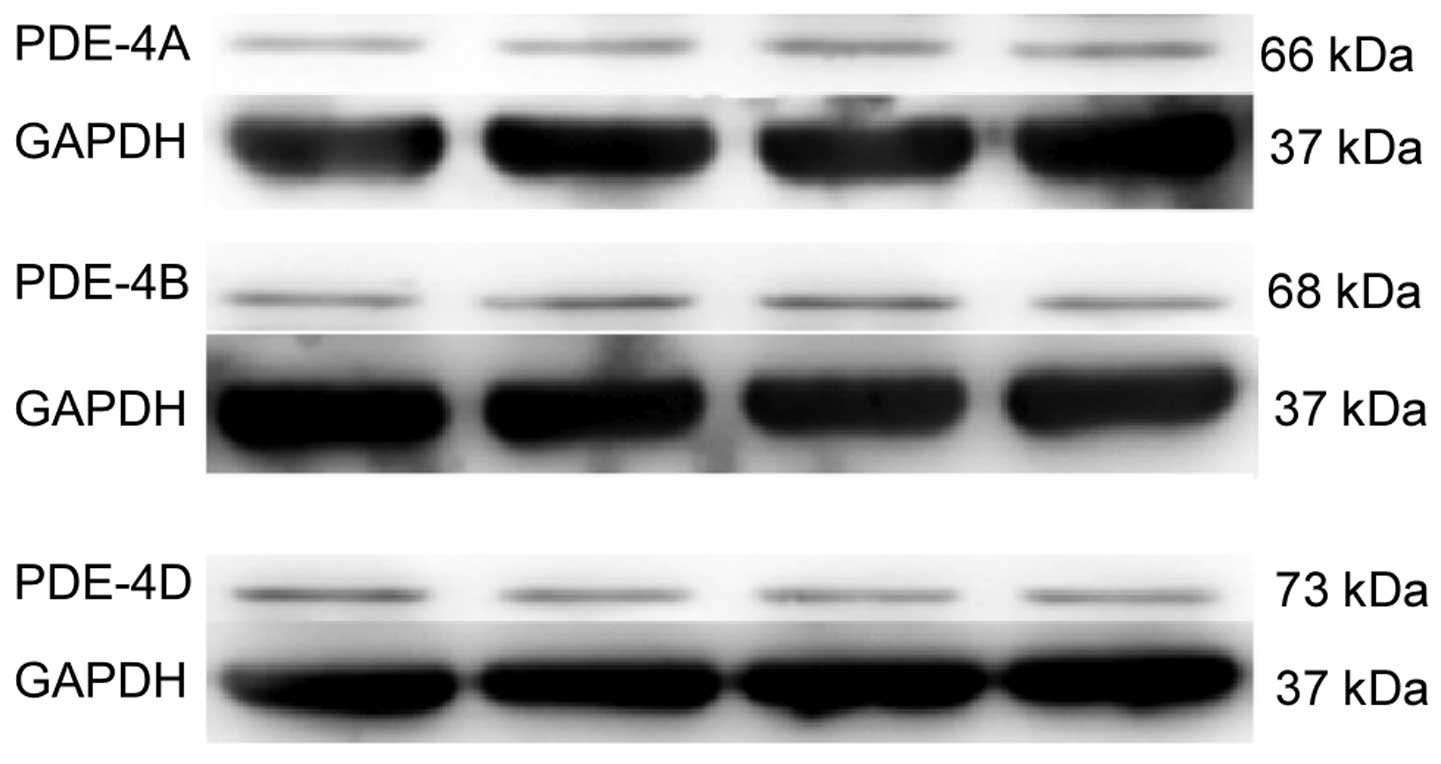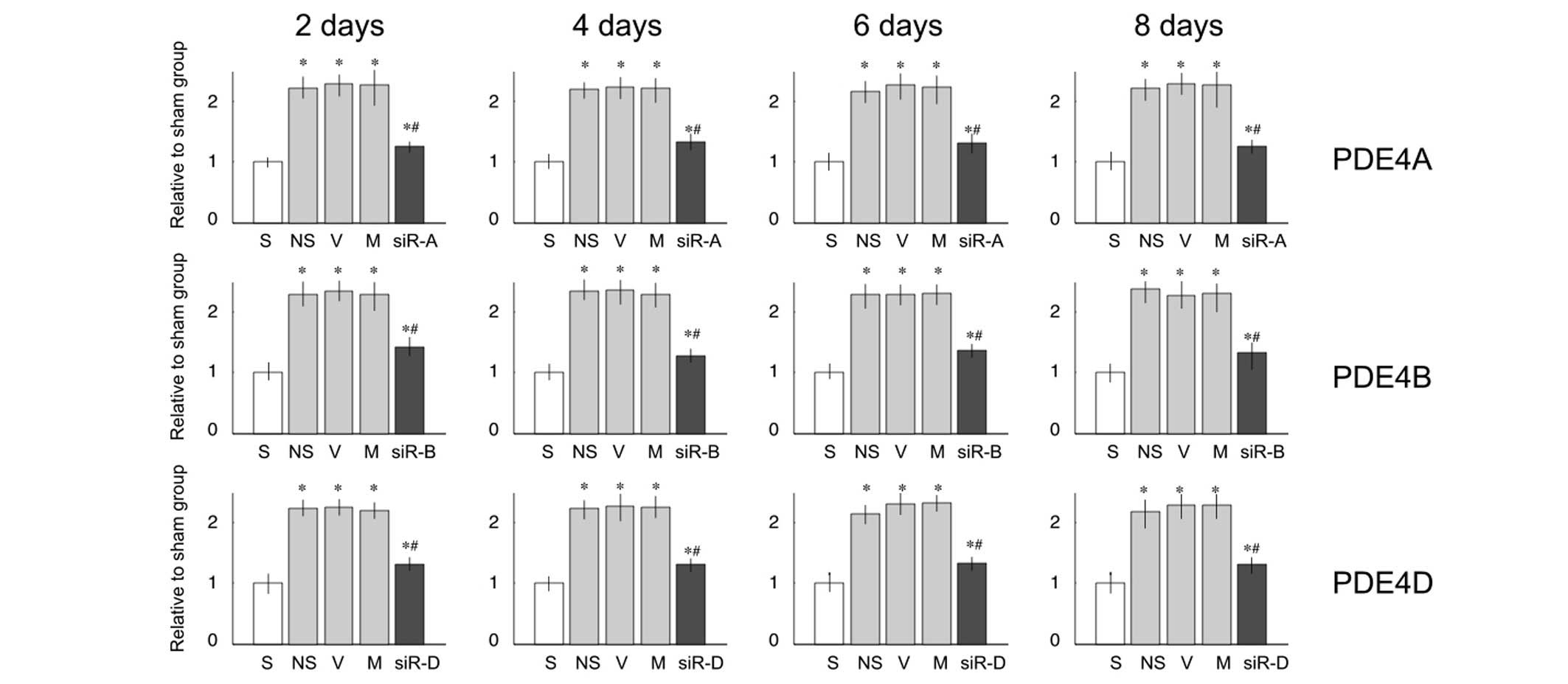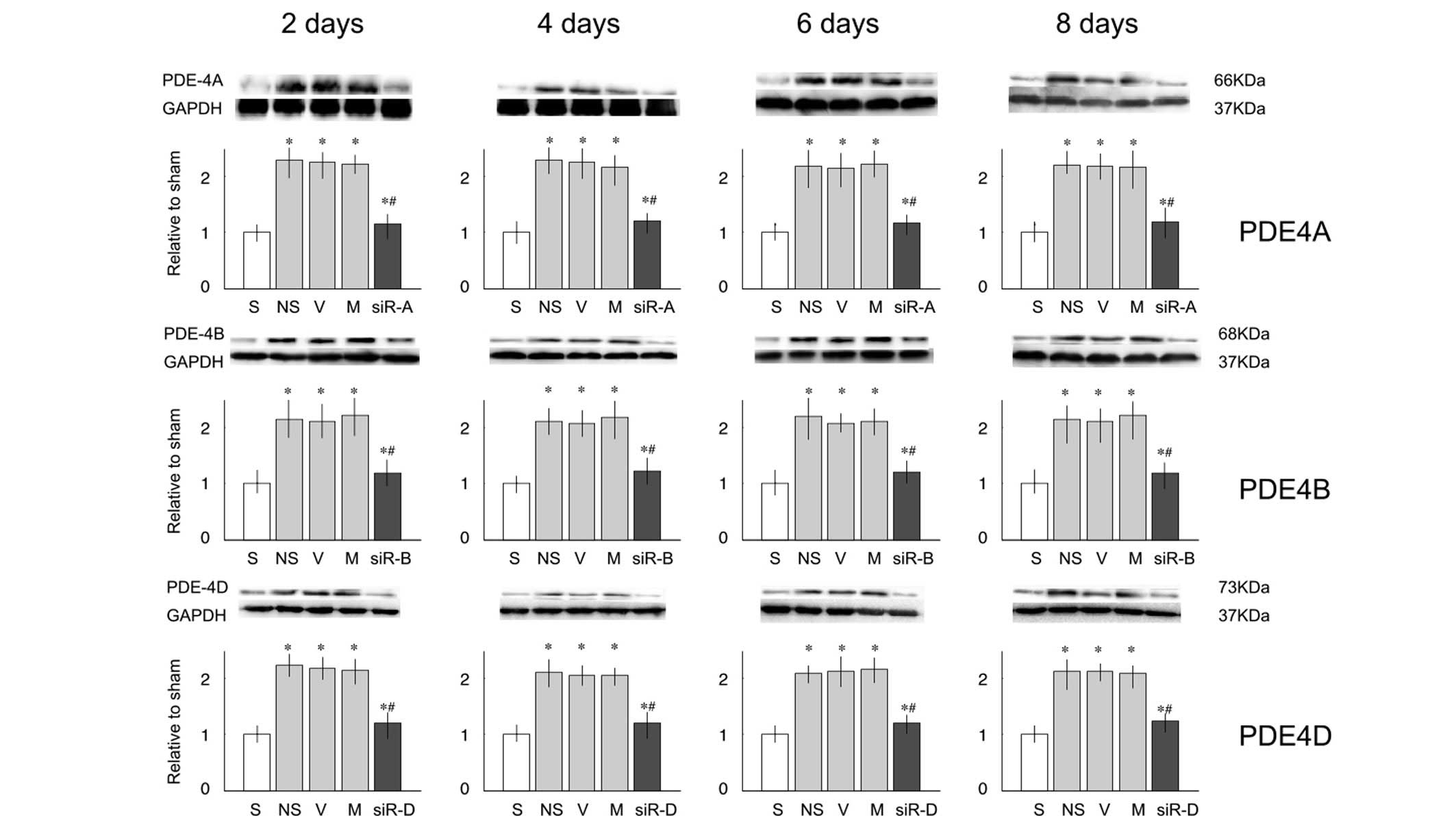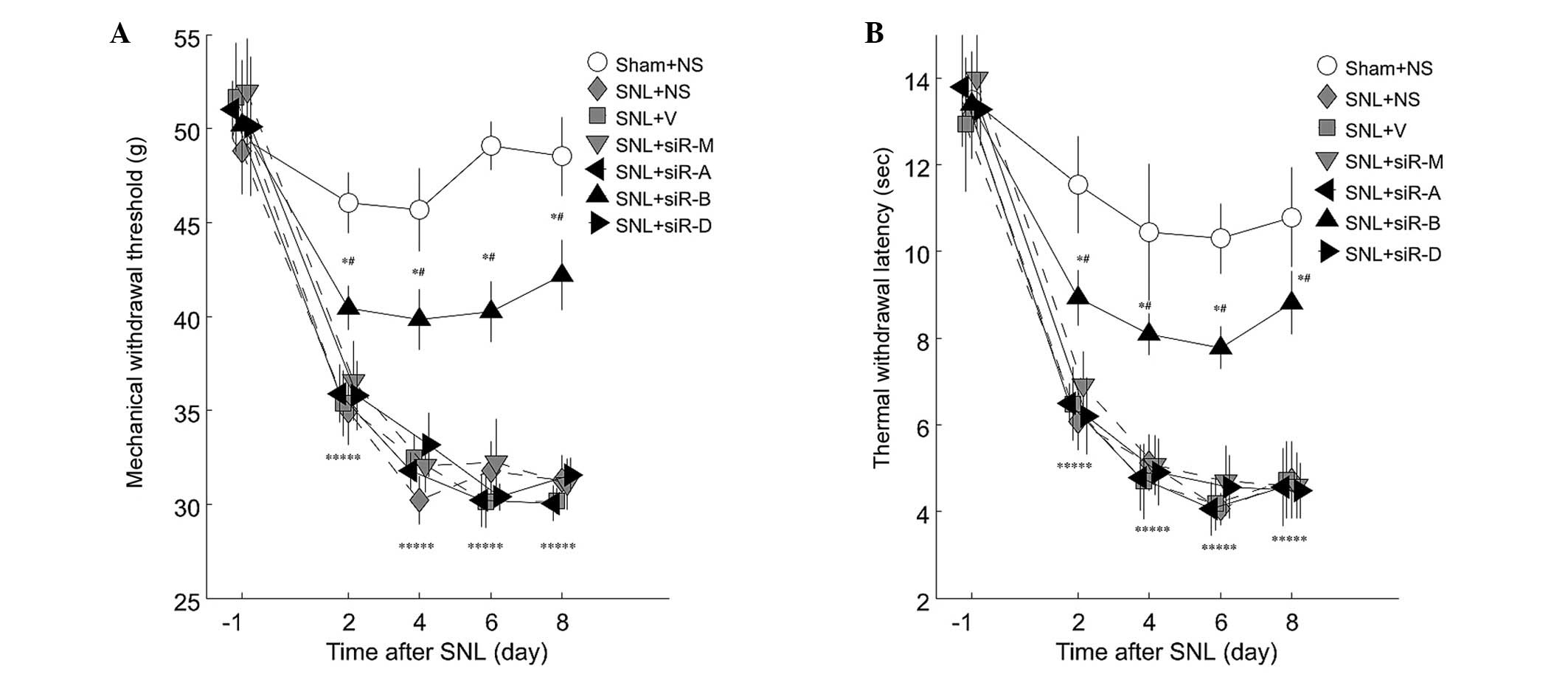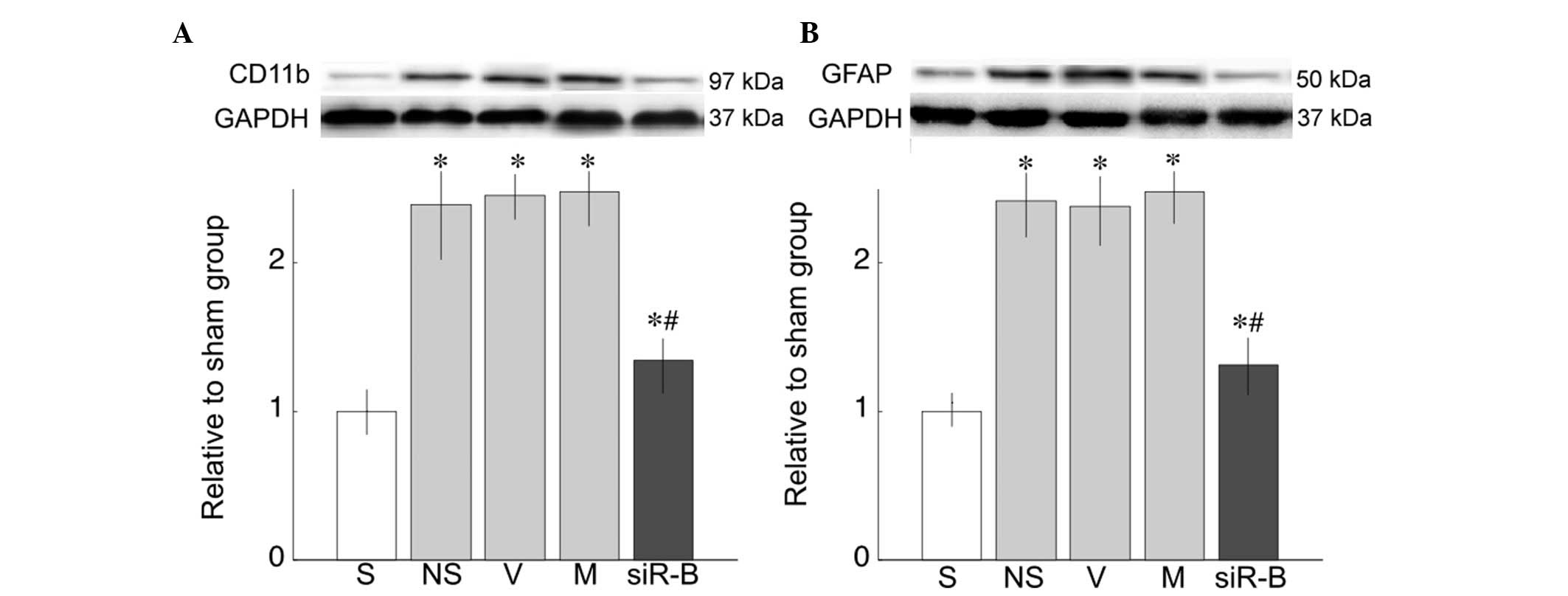|
1
|
Dworkin RH, O'Connor AB, Backonja M,
Farrar JT, Finnerup NB, Jensen TS, Kalso EA, Loeser JD, Miaskowski
C, Nurmikko TJ, et al: Pharmacologic management of neuropathic
pain: Evidence-based recommendations. Pain. 132:237–251. 2007.
View Article : Google Scholar : PubMed/NCBI
|
|
2
|
Attal N, Cruccu G, Baron R, Haanpää M,
Hansson P, Jensen TS and Nurmikko T; European Federation of
Neurological Societies: EFNS guidelines on the pharmacological
treatment of neuropathic pain: 2010 revision. Eur J Neurol.
17:e1113–e1188. 2010. View Article : Google Scholar
|
|
3
|
Gao YJ and Ji RR: Targeting astrocyte
signaling for chronic pain. Neurotherapeutics. 7:482–493. 2010.
View Article : Google Scholar : PubMed/NCBI
|
|
4
|
Tsuda M, Inoue K and Salter MW:
Neuropathic pain and spinal microglia: A big problem from molecules
in 'small' glia. Trends Neurosci. 28:101–107. 2005. View Article : Google Scholar : PubMed/NCBI
|
|
5
|
Watkins LR and Maier SF: Glia: A novel
drug discovery target for clinical pain. Nat Rev Drug Discov.
2:973–985. 2003. View
Article : Google Scholar : PubMed/NCBI
|
|
6
|
Liou JT, Liu FC, Hsin ST, Yang CY and Lui
PW: Inhibition of the cyclic adenosine monophosphate pathway
attenuates neuropathic pain and reduces phosphorylation of cyclic
adenosine monophosphate response element-binding in the spinal cord
after partial sciatic nerve ligation in rats. Anesth Analg.
105:1830–1837. 2007. View Article : Google Scholar : PubMed/NCBI
|
|
7
|
Taskén K and Aandahl EM: Localized effects
of cAMP mediated by distinct routes of protein kinase A. Physiol
Rev. 84:137–167. 2004. View Article : Google Scholar : PubMed/NCBI
|
|
8
|
Ottonello L, Morone MP, Dapino P and
Dallegri F: Cyclic AMP-elevating agents down-regulate the oxidative
burst induced by granulocyte-macrophage colony-stimulating factor
(GM-CSF) in adherent neutrophils. Clin Exp Immunol. 101:502–506.
1995. View Article : Google Scholar : PubMed/NCBI
|
|
9
|
Pearse DD, Pereira FC, Marcillo AE, Bates
ML, Berrocal YA, Filbin MT and Bunge MB: cAMP and Schwann cells
promote axonal growth and functional recovery after spinal cord
injury. Nat Med. 10:610–616. 2004. View
Article : Google Scholar : PubMed/NCBI
|
|
10
|
Pryzwansky KB and Madden VJ: Type 4A
cAMP-specific phosphodiesterase is stored in granules of human
neutrophils and eosinophils. Cell Tissue Res. 312:301–311. 2003.
View Article : Google Scholar : PubMed/NCBI
|
|
11
|
Lugnier C: Cyclic nucleotide
phosphodiesterase (PDE) super-family: A new target for the
development of specific therapeutic agents. Pharmacol Ther.
109:366–398. 2006. View Article : Google Scholar
|
|
12
|
Lynch MJ, Hill EV and Houslay MD:
Intracellular targeting of phosphodiesterase-4 underpins
compartmentalized cAMP signaling. Curr Top Dev Biol. 75:225–259.
2006. View Article : Google Scholar : PubMed/NCBI
|
|
13
|
Gwak YS and Hulsebosch CE: Remote
astrocytic and microglial activation modulates neuronal
hyperexcitability and below-level neuropathic pain after spinal
injury in rat. Neuroscience. 161:895–903. 2009. View Article : Google Scholar : PubMed/NCBI
|
|
14
|
Liu J, Feng X, Yu M, Xie W, Zhao X, Li W,
Guan R and Xu J: Pentoxifylline attenuates the development of
hyperalgesia in a rat model of neuropathic pain. Neurosci Lett.
412:268–272. 2007. View Article : Google Scholar
|
|
15
|
Hama A, Broadhead A, Lorrain DS and Sagen
J: The antinociceptive effect of the asthma drug ibudilast in rat
models of peripheral and central neuropathic pain. J Neurotrauma.
29:600–610. 2012. View Article : Google Scholar
|
|
16
|
Fire A, Xu S, Montgomery MK, Kostas SA,
Driver SE and Mello CC: Potent and specific genetic interference by
double-stranded RNA in Caenorhabditis elegans. Nature. 391:806–811.
1998. View Article : Google Scholar : PubMed/NCBI
|
|
17
|
Doré-Savard L, Roussy G, Dansereau MA,
Collingwood MA, Lennox KA, Rose SD, Beaudet N, Behlke MA and Sarret
P: Central delivery of Dicer-substrate siRNA: A direct application
for pain research. Mol Ther. 16:1331–1339. 2008. View Article : Google Scholar : PubMed/NCBI
|
|
18
|
Zimmerman M: Ethical guidelines for
investigations of experimental pain in conscious animals. Pain.
16:109–110. 1983. View Article : Google Scholar
|
|
19
|
Elbashir SM, Harborth J, Lendeckel W,
Yalcin A, Weber K and Tuschl T: Duplexes of 21-nucleotide RNAs
mediate RNA interference in cultured mammalian cells. Nature.
411:494–498. 2001. View
Article : Google Scholar : PubMed/NCBI
|
|
20
|
Kawamata T, Omote K, Kawamata M, Iwasaki H
and Namiki A: Antinociceptive interaction of intrathecal
alpha2-adrenergic agonists, tizanidine and clonidine, with
lidocaine in rats. Anesthesiology. 87:436–448. 1997. View Article : Google Scholar : PubMed/NCBI
|
|
21
|
Chung JM, Kim HK and Chung K: Segmental
spinal nerve ligation model of neuropathic pain. Methods Mol Med.
99:35–45. 2004.PubMed/NCBI
|
|
22
|
Livak KJ and Schmittgen TD: Analysis of
relative gene expression data using real-time quantitative PCR and
the 2(-Delta Delta C(T)) Method. Methods. 25:402–408. 2001.
View Article : Google Scholar
|
|
23
|
Zhang GH, Lv MM, Wang S, Chen L, Qian NS,
Tang Y, Zhang XD, Ren PC, Gao CJ, Sun XD and Lu LX: Spinal
astrocytic activation is involved in a virally-induced rat model of
neuropathic pain. PLoS One. 6:e230592011. View Article : Google Scholar : PubMed/NCBI
|
|
24
|
Liu PY, Lu CL, Wang CC, Lee IH, Hsieh JC,
Chen CC, Lee HF, Lin HC, Chang FY and Lee SD: Spinal microglia
initiate and maintain hyperalgesia in a rat model of chronic
pancreatitis. Gastroenterology. 142:165–173. 2012. View Article : Google Scholar
|
|
25
|
Whitaker CM, Beaumont E, Wells MJ,
Magnuson DS, Hetman M and Onifer SM: Rolipram attenuates acute
oligodendrocyte death in the adult rat ventrolateral funiculus
following contusive cervical spinal cord injury. Neurosci Lett.
438:200–204. 2008. View Article : Google Scholar : PubMed/NCBI
|
|
26
|
Schaal SM, Garg MS, Ghosh M, Lovera L,
Lopez M, Patel M, Louro J, Patel S, Tuesta L, Chan WM and Pearse
DD: The therapeutic profile of rolipram, PDE target and mechanism
of action as a neuroprotectant following spinal cord injury. PLoS
One. 7:e436342012. View Article : Google Scholar : PubMed/NCBI
|
|
27
|
Vicini E and Conti M: Characterization of
an intronic promoter of a cyclic adenosine 3′,5′-monophosphate
(cAMP)-specific phosphodiesterase gene that confers hormone and
cAMP inducibility. Mol Endocrinol. 11:839–850. 1997.PubMed/NCBI
|
|
28
|
Hajjhussein H, Suvarna NU, Gremillion C,
Chandler LJ and O'Donnell JM: Changes in NMDA receptor-induced
cyclic nucleotide synthesis regulate the age-dependent increase in
PDE4A expression in primary cortical cultures. Brain Res.
1149:58–68. 2007. View Article : Google Scholar : PubMed/NCBI
|
|
29
|
Sebastiani G, Morissette C, Lagacé C,
Boulé M, Ouellette MJ, McLaughlin RW, Lacombe D, Gervais F and
Tremblay P: The cAMP-specific phosphodiesterase 4B mediates
Abeta-induced microglial activation. Neurobiol Aging. 7:691–701.
2006. View Article : Google Scholar
|
|
30
|
Reyes-Irisarri E, Sánchez AJ,
García-Merino JA and Mengod G: Selective induction of cAMP
phosphodiesterase PDE4B2 expression in experimental autoimmune
encephalomyelitis. J Neuropathol Exp Neurol. 66:923–931. 2007.
View Article : Google Scholar : PubMed/NCBI
|
|
31
|
Zhuang ZY, Gerner P, Woolf CJ and Ji RR:
ERK is sequentially activated in neurons, microglia, and astrocytes
by spinal nerve ligation and contributes to mechanical allodynia in
this neuropathic pain model. Pain. 114:149–159. 2005. View Article : Google Scholar : PubMed/NCBI
|
|
32
|
Choi DC, Lee JY, Lim EJ, Baik HH, Oh TH
and Yune TY: Inhibition of ROS-induced p38MAPK and ERK activation
in microglia by acupuncture relieves neuropathic pain after spinal
cord injury in rats. Exp Neurol. 236:268–282. 2012. View Article : Google Scholar : PubMed/NCBI
|
|
33
|
Li W, Li Y, Zhu S, Ji Q, Shu Y, Zhang L
and Liu J: Rosuvastatin attenuated the existing morphine tolerance
in rats with L5 spinal nerve transection through inhibiting
activation of astrocytes and phosphorylation of ERK42/44. Neurosci
Lett. 584:314–319. 2015. View Article : Google Scholar
|
|
34
|
Aronoff DM, Canetti C, Serezani CH, Luo M
and Peters-Golden M: Cutting edge: Macrophage inhibition by cyclic
AMP (cAMP): Differential roles of protein kinase A and exhange
protein directly activated by cAMP-1. J Immunol. 174:595–599. 2005.
View Article : Google Scholar : PubMed/NCBI
|
|
35
|
Emery AC and Eiden LE: Signaling through
the neuropeptide GPCR PAC1, induces neuritogenesis via a single
linear cAMP- and ERK-dependent pathway using a novel cAMP sensor.
FASEB J. 26:3199–3211. 2012. View Article : Google Scholar : PubMed/NCBI
|
|
36
|
Woo MS, Jang PG, Park JS, Kim WK, Joh TH
and Kim HS: Selective modulation of lipopolysaccharide-stimulated
cytokine expression and mitogen-activated protein kinase pathways
by dibutyryl-cAMP in BV2 microglial cells. Brain Res Mol Brain Res.
113:86–96. 2003. View Article : Google Scholar : PubMed/NCBI
|
|
37
|
Zhao L and Brinton RD: Suppression of
proinflammatory cytokines interleukin-1beta and tumor necrosis
factor-alpha in astrocytes by a V1 vasopressin receptor agonist: A
cAMP response element-binding protein-dependent mechanism. J
Neurosci. 24:2226–2235. 2004. View Article : Google Scholar : PubMed/NCBI
|
|
38
|
Liu J, Zhao X, Cao J, Xue Q, Feng X, Liu
X, Zhang F and Yu B: Differential roles of PKA and Epac on the
production of cytokines in the endotoxin-stimulated primary
cultured microglia. J Mol Neurosci. 45:186–193. 2011. View Article : Google Scholar
|















